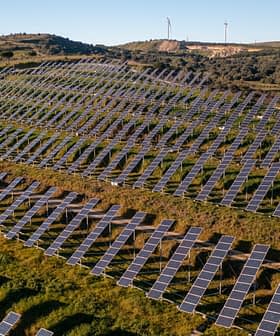A growing number of countries are accelerating their transition to green energy, according to the Global Electricity Report 2022.
In 2021, 38 percent of global electricity was produced by wind and solar generation. In total, 50 countries produce at least 10 percent of their electricity through wind and solar technologies.
The major outcome of the report is warning that countries need to reach clean power generation by 2035… To get there, the biggest assets are wind and solar.
Momentum is building, but the report, which Ember, a think tank, compiled, said this pace must accelerate to efficiently curtail greenhouse gas (GHG) emissions and prevent the worst-case climate change scenarios from coming to fruition.
Despite the growing share of renewables, Ember warned that this growth was not offsetting fossil fuels, the consumption of which also continues to grow.
See Also:Climate Coverage“Wind and solar will be the backbone of the electricity generation system in the future; there is no doubt about that,” Elisabeth Cremona, an energy and climate data analyst at Ember, told Olive Oil Times. “That happens as renewables will be increasingly relevant to electricity production and, among them, wind and solar will play the most relevant role.”
Global solar generation rose 23 percent in 2021, faster growth than at any point in the past 17 years. In this period, solar energy production capacity increased from 188 terawatt-hour (TWh) to 1,023 TWh.
In 2015, solar power covered 1.1 percent of the global electricity demand and in 2021 it met 3.7 percent of the world’s electricity needs.
Ember researchers noted how in order to reach climate goals, that percentage should rise to 19 percent by 2030, which means solar power should grow 24 percent every year of this decade.
Given that it grew 23 percent in 2020 and averaged 33 percent over the last 10 years, experts believe the target is within reach.
On a global scale, wind power grew in 2021 more quickly than ever before, rising 14 percent and bringing total electricity output to 1,814 TWh. After solar, wind has been the fastest growing source of electricity during the past year and now accounts for 6.6 percent of total electricity compared with the 3.5 percent reported in 2015.
According to Ember, coal generation in 2021 is also substantially rising, being 10 percent higher when compared to 2015, the year 192 countries agreed to curtail GHG emissions as they signed the Paris Agreement.
In 2021, Ember noted how carbon dioxide emissions from the power sector rose by 7 percent, which is the largest absolute rise ever.
Ember warned that coal power should fall by 13 percent every year during the current decade to meet climate targets set by the United Nations summits on climate change, which means reducing the role of coal power globally from 36 percent to 8 percent by 2030.
However, in the six years since the Paris Agreement was signed, China, the world’s largest burner of coal, has seen its share of coal-fired power rise by 33 percent. By comparison, this figure has fallen by 8 percent in the rest of the world.
At the same time, China has the most significant investment in wind farms, which grew 65 percent in 2021, adding 148 TWh, roughly enough electricity to power Argentina.
While the country is quickly adopting renewables and clean energy sources, the growth of the electricity demand is rising at an even faster pace. As a result, coal continues to fill the gap, meeting 64 percent of the electricity demand rise.
“The major outcome of the report is warning that countries need to reach clean power generation by 2035 if the global climate target of a 1.5 ºC surface temperature rise is to be met,” Cremona said. “To get there, the biggest assets are wind and solar, and therefore those should inform global policies in the energy sector.”
“Electricity demand rise is fueled by three main factors,” she added. “The first being the recovery from the Covid-19 pandemic. The second is that many economies, especially in Asia and not only China, are sustaining an economic boom, which fuels electricity demand growth.”
“The third element is electrification, actually being part of decarbonization solutions,” Cremona continued. “This means that in many countries, such as those in Europe, we expect demand to grow strongly as electricity is increasingly perceived as an alternative to gas, with heating, for instance, began shifting from gas to heater pumps.”
Europe was one of the first regions to begin its energy transition, and Cremona said the continent could serve as a role model for other regions to make the transition without harming their economies.
“There is a push for Europe to be at the forefront as a good model on how the energy transition can happen in a sustainable, just way,” Cremona said. “That happens through the drive of the policies, which allow the rest of the world to see an economy flourishing within a decarbonized system. This is where the European narrative sets in, showing that you can have a good economy even decreasing your emissions.”
“What we see in Europe as a reaction to rising gas prices and the Russian war in Ukraine is that many countries are coming out strong in their green energy transition programs. There is this drive to speed things up,” Cremona added. “Germany, for instance, has just released an energy plan which aims at having 100 percent renewables within 2030.”
One of the keys to tackling global emissions is to strengthen cooperation with developing countries that might not have the resources to boost clean energy production.
“We are seeing this happening more,” Cremona said. “This was also reinforced at COP26. Some countries are moving more quickly on that. China, for instance, is the most active in signing these agreements. Within Europe, we are also seeing a growing cooperation fostering transition and decarbonization.”
According to Ember, the transition to green energy is taking its first steps in an overly complex world where energy markets depend on resource availability, conflicts, technology, policies and financing.
The transition is also occurring in the backdrop of the crescendoing effects of climate change – from severe drought and wildfires to shifts in ocean currents, all of which are having a profound impact on food production and populations.
The report optimistically concluded that there is still time to curtail surface temperature growth, but the urgency grows exponentially.
“We do have reports, such as last week’s IPCC report, which tells us that we can still make it if action happens immediately,” Cremona said. “This is positive because it tells us that there still is a window of opportunity.”
“But there is also a slightly negative element if we see the latest IPCC data, as the reduction of emissions projected three years ago did not progress,” she concluded. “That means that in just three years the situation has worsened, and we should now reduce emissions even more quickly than previously estimated.”








